 |
 |
News |
|
 |
| |
|
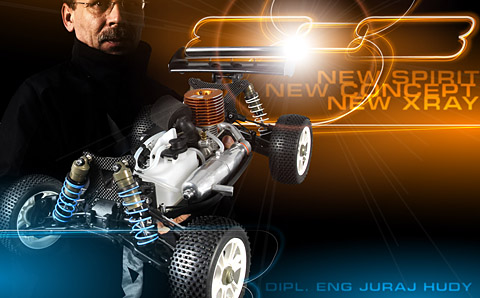
(click to enlarge) |
|
|
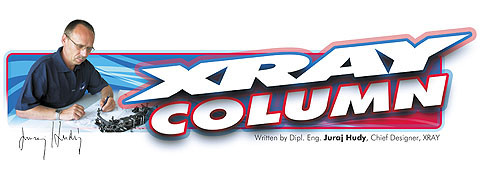
|
|
|
|
| Since the autumn of 2007 when I decided to focus all our energy, efforts and resources to the next development of the XB8, we made huge progress and development went through some hectic and radical changes. In some of my previous columns I disclosed our initial idea and strategy for the new development of the XB8 platform and showed the first ideas and concepts which were tested at European and US tracks (with myself experiencing and getting my own feedback in the US at the Worlds track in Charlotte and at the Worlds Nitro Cross race in Las Vegas). After returning to the factory and evaluating all the data and records on hand â“ and after collecting feedback from other drivers which tested the new concept â“ I was still not happy with the results. I had the feeling that if we wanted to get the XB8 to the next level, we would need to change the concept. Trying to massage the current XB8 concept even more, I felt that we would get limited here and there and would still need to make compromises at a certain point. And to make compromising decisions in the high-competition field is something I really do not like to do. I was facing a dilemma. |
|
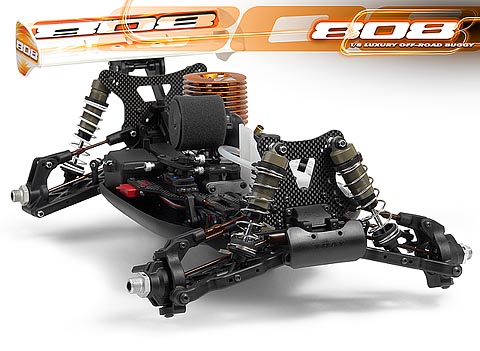
(click to enlarge) |
|
|
|
The result of all the analysis and comparison was clear and supported two choices only: (1) continue to work around the XB8 platform and try to improve the areas I knew needed attention (and thus have the new car ready very quickly), or (2) move away from the XB8 platform and build the car on an all-new platform, which of course would require plenty of new moulds and give less chance of getting the car to market for early spring. After some demanding discussions and analyzing the possible timeframes I decided for nothing less than a no-compromise direction â“ to build an all-new platform.
As usual with any big changes you have to start from scratch which was what we did. We had clear knowledge of the areas we needed to improve, and the first thing to change was the suspension and geometry⦠completely change it. To improve steering and handling in bumpy conditions, I decided to use the suspension concept that has been used for ages in 1/10 electric off-road cars⦠the âśzero kingpinâť design. This design seems to work in the 1/8 buggy scale as well and the first prototypes were created for testing. Zero kingpin suspension gives more precise steering and handling in the corners as the steering keeps the same angle no matter if the suspension is up or down, and as such when running through bumps in corner the steering will not change as much as on regular C-hub suspension used previously and the handling of the car will improve significantly. Working around the suspension parts I thought that the heavy caster block and steering block could definitely be improved upon so as to prevent steering blockage when the steering pins in the caster block become blocked in dust. Working out these ideas I came up with some ideas: why not to use what has already working great in the previous XB8 platform? That is, use tiny composite steering blocks but with molded in steel bushings and use screws that pass through the caster block into the bushings. This concept allowed us to completely change the design and look of the caster block and steering block and mainly reduced the weight. It also significantly reduces the risk of locked steering. |
|
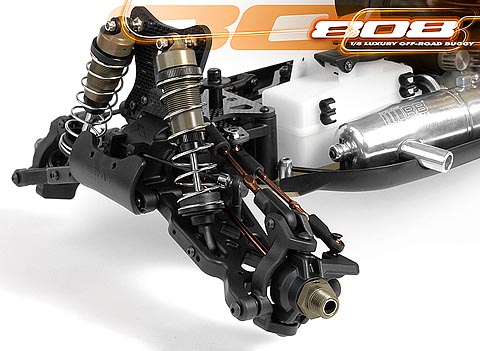
(click to enlarge) |
|
|
|
| With the new suspension concept I had to rework the chassis geometry as well. The zero kingpin suspension is not overly sensitive to weight load, so I could bring the engine and center diffs more towards the chassis which of course has greatly helped in the bumpy areas of the tracks as well. The suspension arms are an all-new design and this time we spent more effort to find a better balance between the strength and flexibility of the suspension arms, as these are the main factors that influence handling on any model car. Based on our extensive knowledge of composite formulation, we already knew what would not work so this time it is much easier to go into areas which I knew would surely work but at the same time test something else and different to at least to gain a bit more knowledge with new mixtures. What I expected has been confirmed. We went with the proven composite mixtures since the tiny design of the suspension arms required strong yet flexible composites with memory which would ensure that the arms will survive impacts and jumps but still return to their original shape⦠all while being flexible enough to generate grip. To generate grip and make the car more forgiving, I decided to go with composite suspension holders which we have successfully used in the XT8 truggy. The dilemma I had was whether or not to make the suspension holders adjustable. My experience over the years has taught me that regular off-road customers do not have or need extensive knowledge and experience with set-ups and many of them even do not own a set-up system or the necessary set-up tools to make precise set-up adjustments. As such I have seen very weird set-ups on cars and not surprising the owners are not satisfied with the handling. After a brief tech explanation and setting up the cars for such customers, I could see the smiles of satisfaction on their faces after they drove the cars. This lead me to the conclusion that for a standard out-of-the-box car we needed to make one integrated set-up setting which would make the car easy to drive and predictable, but also be fast and forgiving. Therefore I decided to make one general basic set-up geometry that was preset into the suspension holders so nobody could ever get lost by putting a weird setup into the car, or having something mixed or upside-down. Of course for experienced drivers and top drivers looking for the edge of the performance, the optional alu suspension holders with fully-adjustable geometry would be available but as an option only. |
|
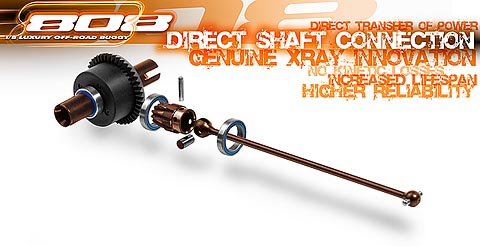
(click to enlarge) |
|
|
|
| To improve the performance of the car we needed not only to reduce the overall weight but also reduce the weight of rotating parts and unsprung weight to gain better performance; I therefore decided to redesign the drivetrain concept. We went with a 43T front diff gear and 10T pinion gear, and with the new ratio it helped to use smaller center diff gears to keep the weight down. I have studied and worked around the drivetrain for a long time to look for the highest performance edge and as such to reduce the weight we needed to reduce not only weight of the parts but to try to reduce the number of parts as well. At one time I came up with an idea that I consider to be one of my better ideas, that being to connect the central drive shafts directly to the pinion gears in the diff houses. Why should we use connecting shafts when we can transfer the power directly through one shaft to the pinion? This reduces the center connecting shaft, resulting in less physical weight (and rotating weight) and less chance of losing setscrews; the smart design of our new Direct Shaft Connection allowed me to locate the connecting pin inside a bearing and as such the pin will never drop out and the drive shaft will never disconnect. I was proud that we came up with this new and innovative design, and even if it is at first sight a small thing, the small things tend to drive development further and make the overall package a better one. |
|
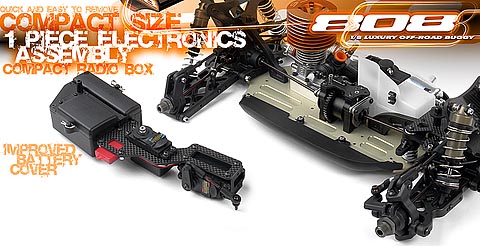
(click to enlarge) |
|
|
|
One of the concerns I had was the loss of kinetic energy by having the central shafts angled which was a natural result of the position of the central diff, which had to be moved to the right side to balance the weight movement of the engine, muffler and fuel tank. In redesigning the layout and making the chassis ultra-narrow, it was moved more toward the centerline. We did a lot of testing in computer using specialized software that analyzes different angles and positions of the central drive shafts and their connection to the diff housing. We found out that the loss is so insignificant that nobody in the world can ever feel the difference. That was a great information for me as I was really happy with the new layout of the car which was now much much better balanced and had dramatically improved weight distribution not only front-to-rear but also side-to-side. The confirmation that there is no loss in drivetrain efficiency by having the central drive shafts angled has confirmed we could go into the next stage of development which was working on all the smallest details.
With the no-compromise design strategy in mind I have worked around every detail to reduce weight, make the parts stronger & more reliable & more efficient, and as such dozens of things and parts were changed. There are simply too many to list in one column only, so very briefly here are the key decisions and design changes which were taken besides the already mentioned significant changes: |
|
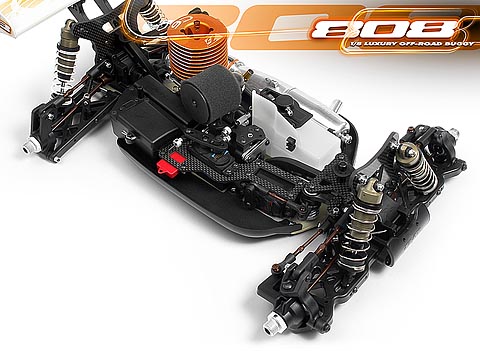
(click to enlarge) |
|
|
|
⢠The aluminum radio plate, front upper deck and center diff plate were exchanged for lightweight graphite and composite pieces which at the same time provide improved flex. Despite loving the original and authentic black aluminum with silver edges of the previous parts, saving weight was at the top of the priority list. And tragically, there are plenty of cars now on the market that have followed the use of our black/silver design, so essentially it was no longer a distinguishable XRAY exclusive design.
⢠To reduce weight in the upper part of the car, the beautiful but heavy aluminum shock towers had to be replaced with lightweight graphite shock towers. The rear shock tower (which is not exposed to heavy crashes) was made from 3.5mm graphite, while the front shock tower (which is more prone to being involved in most crashes and rollovers) was made from extra-thick 4mm graphite.
⢠To make the suspension blocks smaller we needed to change to lighter ball bearings. But to make sure the bearings would not suffer overload issues, they were placed farther apart to better carry the load of the wheel axle.
⢠The all-new shocks were completely redesigned. To make them easier to assemble I decided upon a 1-piece aluminum upper cap which is a bit heavier but is very strong and never breaks and also makes assembly easier. Based on customer demand we decided upon threaded shock bodies and of course the shocks were increased in diameter to become true big-bore shocks. The lower area for mounting the o-rings was redesigned to minimize oil leakage and the dust protector was incorporated into the lower shock cap to keep dirt outside of the shocks. |
|
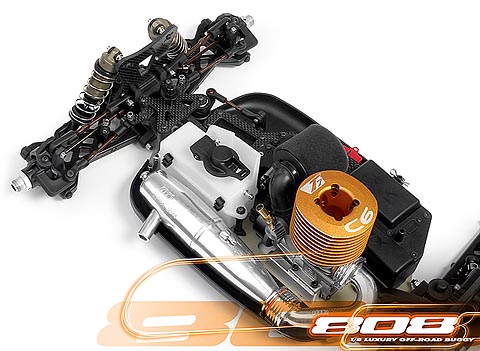
(click to enlarge) |
|
|
|
⢠To solve the problem with the clutchbell bearings, I redesign the clutchbell to accommodate a larger clutchbell bearing and have purposely-designed ball-bearing with big balls and big overall size to carry the high load of the clutch.
⢠To solve the problem of chassis bending and the clutchbell crashing into chassis, I wanted to use some kind of chassis brace but that would just add extra weight so I decided to incorporate the chassis brace into the engine mounts.
⢠With the new Direct Central Shaft connection we had to redesign the diff housings. And while having the housings back on the design board I could incorporate better sealing features into the housings. What better way to do that than to use Labyrinth Dust Covers™ for the diff housings where the central shaft connects.
⢠After we got the final weight balance fixed I needed to ensure that not only the suspension but also the chassis would have appropriate flex. The rear composite brace was shortened to provide a bit more flex to the rear but I was still not completely happy with the side flex, so I changed the design of the radio plate and opened the plate around the throttle servo which helped to achieve the flex I was looking for.
⢠To solve the problem of shafts disconnecting or suspension pins falling out I went with a very easy solution. All the connecting pins of drive shafts are now sitting in ball-bearings and as such will never get lost. To eliminate the loss of suspension pins both inboard and outboard we decided that pins which are inserted through the whole suspension and suspension holders will be locked with self-locking nuts. |
|
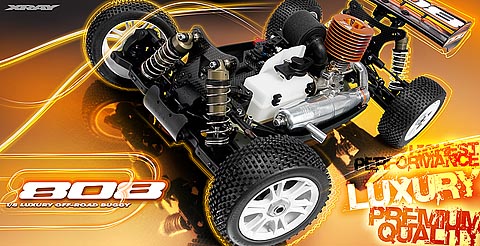
(click to enlarge) |
|
|

|
There are dozens of other details and parts which were reworked and redesigned, all of course with a high competition concept on mind. The finalized car should be ready for display at the Nurnberg Hobby Show.
I will keep you informed about further progress and developments in future columns.
Enjoy the ride and â�til the next time⦠|
|
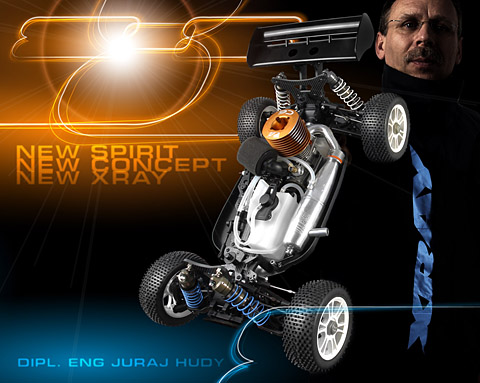
(click to enlarge) |
|
|
|
|
|























